Meybod Caravanserai
Meybod Caravanserai or popular as Shah Abbasi Caravanserai Meybod, built in 1689, sits in the city of Meybod, 56 km northwest of Yazd City. Properly preserved, Meybod Caravanserai is one of the numerous caravanserais of Iran, constructed in Safavid era (1501-1726). It is neighbored by Kolar Water Reservoir (Ab Anbar) on its entrance, an Icehouse (Yakhchal) on its opposite, and a Pony Express (Chapar-Khaneh) on its side. Hence, Meybod sightseeing counts as one of the popular Yazd tourist attractions.
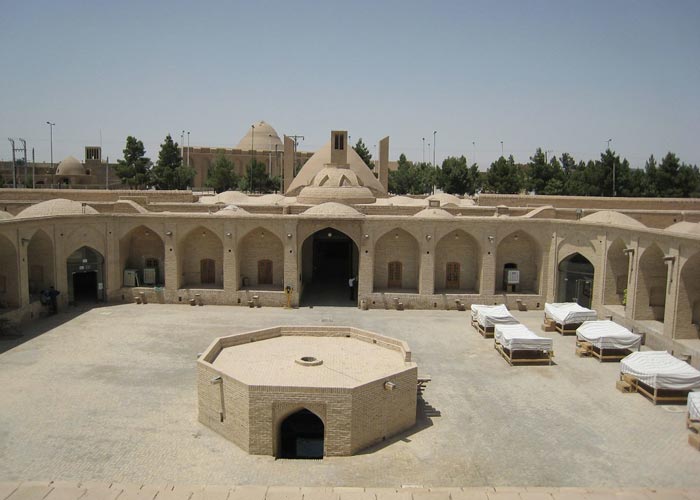
Photo by @lonebiker.net on Flickr
If interested in travelling to Iran too, as an Iranian tour operator, we urge you to visit our Iran tours:
>> Iran Tours 2020 & 2021 (Click Here)
#1 Function of Meybod Caravanserai
Function of Meybod Caravanserai : Caravanserais in Iran date back to Achaemenid Persia and they served as roadside inns for the passing caravans, a group of traveling merchants, traders or any class of travelers of long-distance journeys in old times. Serai or Sara in Persian means “a building with enclosed courts” or “a palace”.
Caravanserais were constructed along the highly commuted Silk Road and major trade or pilgrimage routes throughout history. During the Safavid Era, especially the reign of Shah Abbas the Great, 5th and influential king of Safavid Dynasty, numerous caravanserais were established to facilitate commutes as part of their growing international trade and relations policy, and pilgrimage routes to/from religious cities.

Photo by @Anton-Rogozin on Flickr
Meybod Caravanserai, like its counterparts, did not just offer an austere place to stay the night, but it served travelers with full amenities such as equipped chambers and niches, fresh water access, animal stalls, etc. for a comfortable stay of several days.
Caravanserais also functioned as a platform of dialogue and cultural/commercial exchange among every class of travelers, be it merchants, students or religious missionaries, etc. Some merchants could even promote and sell their commodities in the caravanserai
So, in short, Meybod Caravanserai is an integral member of a vast network of trade and communication. One could say it sustained, at the time, the opportunities that Internet, today, offers to global relations.
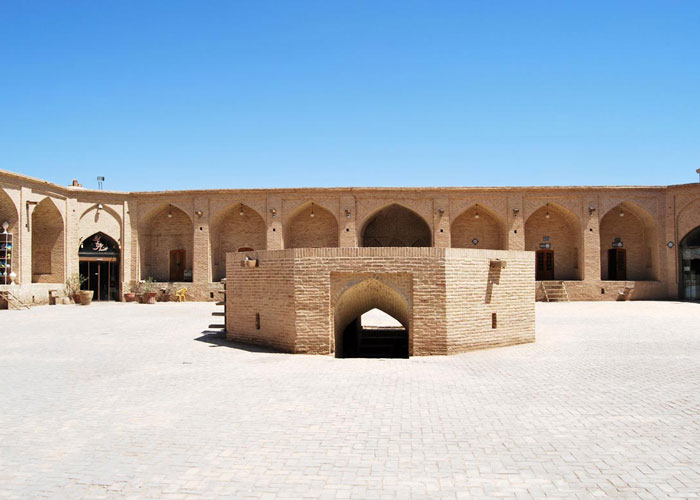
Photo by @Ángel Requena Villar
#2 Meybod Caravanserai Architecture
Meybod Caravanserai Architecture : Typical of most caravanserais of Safavid Era, Shah Abbasi Caravanserai Meybod is an enclosed rectangular brick structure, with a central courtyard, with 4 symmetrical Eyvans (Porches) on each side, surrounded by niches and chambers.
There is only one entrance, an ornate grand Portal, large enough to allow passage of heavily-laden animals such as camels.
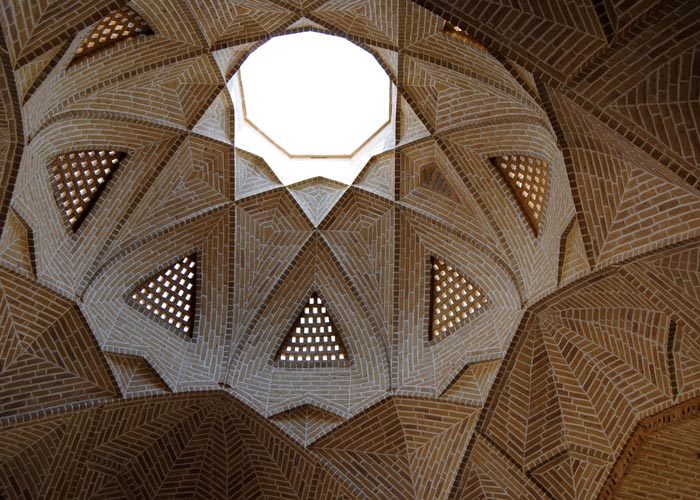
Ornate Ceiling of Meybod Caravanserai Portal Entrance (Photo by @Ennius-Ortnid on Flicker)
Passing through the grand portal and the octagonal vestibule, one finds themselves in a vast rectangular yard, lined with 24 chambers (Hojreh) facing the yard. In the middle of the yard, lies the octagonal “HowzKhaneh” or pond house underground, through which fresh water of Qanat flowed, for the traveler’s consumption . The pond area also served as a cool shelter during the hot seasons.
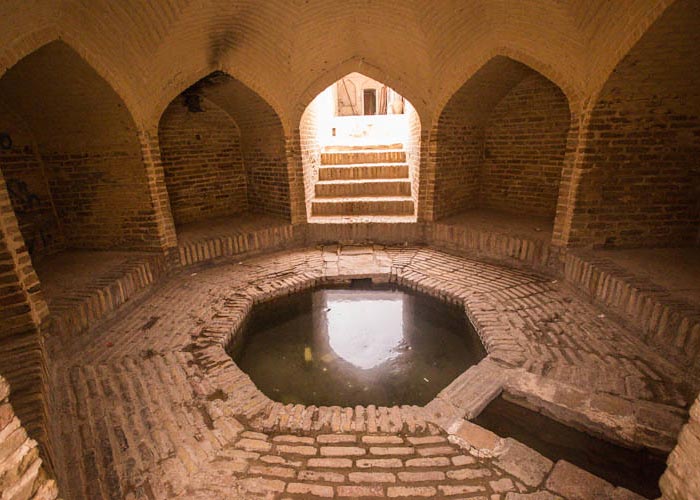
Photo by @sunriseOdyssey on Flickr
Meybod Caravanserai offered 100 chambers or rooms, 24 of which faced the yard, . The rooms were equipped with wall-fitted fire-places for the cold and passive ventilation system during the hot seasons. the dome shaped chamber roofs contributed to the proper ventilation of the space as well.
On the 4 corners of the yard, octagonal vestibules were built to allow access to animal stalls (behind the eastern and western walls) and storage rooms (lined behind the northern and southern chambers) and stairways to the roof.
Meybod Caravanserai sits on a Sabat (roofed alley) and on its opposite lies Kolar Water Reservoir.
#3 What Can You Do in Meybod Caravanserai Now?
What Can You Do in Meybod Caravanserai Now? Nowadays, Meybod Caravanserai, while maintaining its original format and structure, is functional with different tourist activities such as :
#1 Ziloo (Zilu) Museum and Workshop
Located on the eastern side of Meybod Caravanserai, the Zilu Museum showcases flat weave floor coverings or “Ziloo”, dating back to 500 years ago. Ziloo has been the top handicraft of Meybod since old times. One can also enjoy the sight of Ziloo weavers at work there.
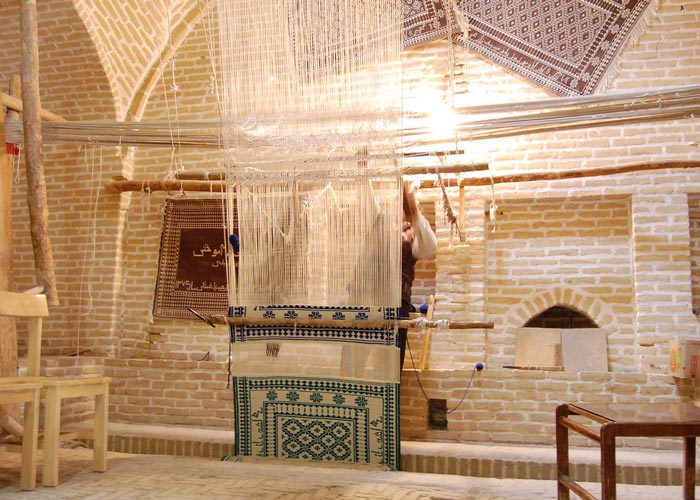
Photo by @Jenny-Brophy on Flickr
#2 Shah Abbasi Traditional Restaurant and Café
Located on the western side of Meybod Caravanserai, is one of the popular dining places in Meybod, both among the locals and tourists. The restaurant has maintained the old format of the caravanserai’s western hall, and offers a delightfully antique ambiance for the traditional Iranian cuisine.

Photo by @lonebiker.net on Flickr
#3 Several Giftshops and Local Handicraft Shops
The old chambers facing the central yard are now home to local artists, promoting the local handicrafts such as scarfs, pottery and various souvenirs.

Photo by @Anton Rogozin on Flickr
#4 Neighbouring Monuments
#1 Kolar Water Reservoir (Ab Anbar-e Kolar)
Built in 1691, is on the opposite side of Meybod Caravanserai, dome and 4 wind catchers of which are noticeable from the street. The desert climate of the region necessitated sophisticated water reservoirs to store water from Qanats, seasonal water streams and rainfalls in the cold seasons for consumption during the dry seasons. The dome structure and 4 wind catchers, with the pond being underground, are all ventilation measures to keep the water reserve fresh, cool and free from bacteria and impurities.

Phot by @Jenny Brophy on Flickr
#2 Icehouse of Meybod
Across the street from Meybod Caravanserai, stands a grand Icehouse from Qajar era (18th-19th century). The icehouse functioned as an ice reservoir for use during the hot seasons . The ponds at the foot of high walls of the icehouse allowed freezing of water in the shade in winter time. Ice blocks were then stored in the underground reservoir with a high dome to facilitate ventilation.

Photo by @phespirit on Flickr
#3 Chaparkhaneh (Pony Express) of Meybod
Now functioning as Post Museum of Meybod is adjacent to Meybod Caravanserai, Chaparkhaneh of Meybod dates back to Qajar era. Serving as an old mail delivery station with the aid of agile couriers and horses, today fibre-glass horses and mannequins are placed in the area to illustrate the various functions of the station, and there’s a museum of stamps and old telephones and typewriters.
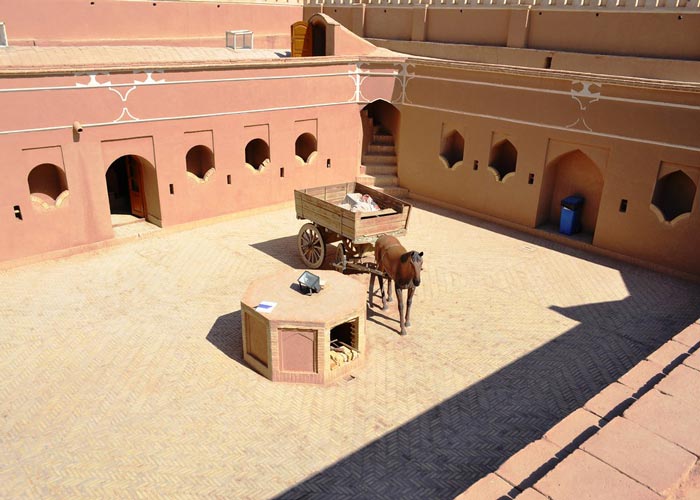
Photo by @Hamidreza Yousefi on Flickr
Nearby Attractions of Shah Abbasi Caravanserai Meybod
- Narin Castle – 700 m
- Pigeon Tower – 1.7 km
Shah Abbasi Caravanserai Meybod Opening Hours and Address
Shah Abbasi Caravanserai Meybod Opening Hours are : 8 – 23, everyday



1 Comment
Joanne · July 8, 2019 at 9:51 am
We visited the site last autumn. Interesting and lively monument, especially with all the small shops. we got the chance to watch an old man weaving Ziloo too